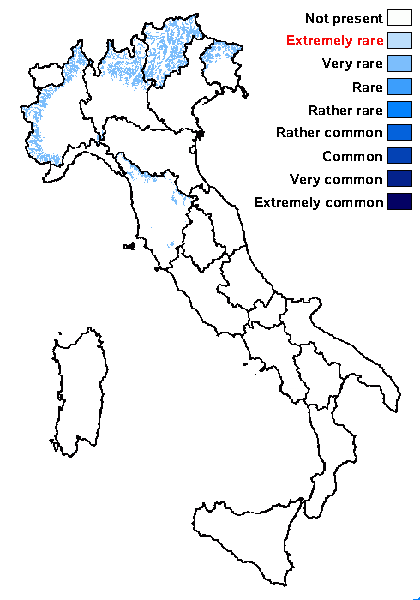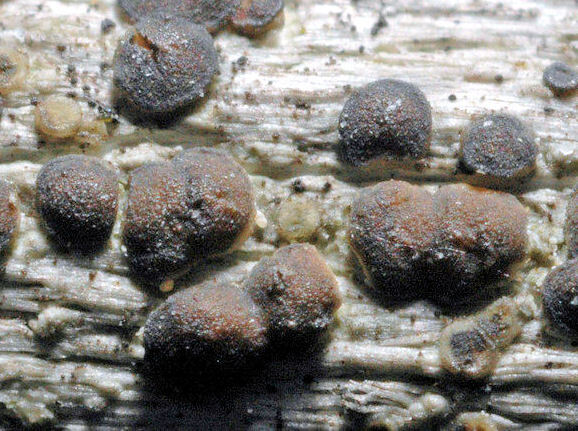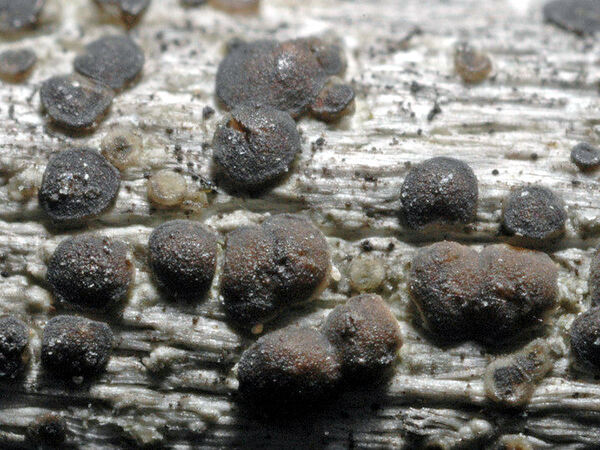Zeora aitema (Ach.) L. M. Weber & Ivanovich-Hichins
in Ivanovich-Hichins & al., Lichenologist, 57: 297, 2025. Basionym: Lecidea aitema Ach. - K. Vetensk.-Akad. Nya Handl., 29: 261, 1808.
Synonyms: Lecanora aitema (Ach.) Hepp; Lecanora aitema f. saepincola (Ach.) Anzi; Lecanora symmicta var. aitema (Ach.) Th. Fr.; Lecanora symmicta var. saepincola (Ach.) Nyl.; Lecanora symmictera var. aitema (Ach.) Nyl.
Distribution: N - Frl, TAA (Dalla Torre & Sarnthein 1902, Nascimbene & al. 2007b), Lomb, Piem (Isocrono & al. 2004). C - Tosc.
Description: Thallus crustose, episubstratic, granular to irregularly areolate, dispersed or continuous, white to yellowish white, forming small patches. Apothecia distinctly lecanorine only when young, but soon appearing biatorine, sessile, 0.2-0.5(-0.6) mm across, with a dark green, red-brown, olive-black to black (often piebald), strongly convex, epruinose disc, and a thin, smooth, soon excluded thalline margin. Epithecium yellowish brown to olive-green, with granules dissolving in K; hymenium colourless, 55-80 µm high; paraphyses branched and anastomosing, 2-2.5 µm thick at mid-level, the apical cells only slightly swollen, up to 3.5 µm wide; hypothecium colourless. Asci 8-spored, clavate, very thin-walled, with a K/I+ blue, tall tholus penetrated by a faintly amyloid apical cushion, the wall K/I-, surrounded by a blue outer layer, Lecanora-type. Ascospores 1-celled, hyaline, narrowly ellipsoid, (10-)12-17 x 4.5-5.5 µm. Photobiont chlorococcoid. Spot tests: thallus K-, C-, KC+ faintly yellow, P-, UV+ pale orange. Chemistry: usnic acid, zeorin.Note: on twigs of Calluna and other shrubs, more rarely on lignum and bark of coniferous trees and oaks. Closely related to Z. symmicta, this species is included in the Italian red list of epiphytic lichens as “Endangered” (Nascimbene & al. 2013c).
Growth form: Crustose
Substrata: bark and lignum
Photobiont: green algae other than Trentepohlia
Reproductive strategy: mainly sexual
Commonnes-rarity: (info)
Alpine belt: absent
Subalpine belt: very rare
Oromediterranean belt: extremely rare
Montane belt: very rare
Submediterranean belt: absent
Padanian area: absent
Humid submediterranean belt: absent
Humid mediterranean belt: absent
Dry mediterranean belt: absent

Predictive model
Herbarium samples

CC BY 4.0 - Source: Ivanovich-Hichins C, Weber L, Li L, et al. New phylogenetic insights into the lichen genus Lecanora s. lat. (Lecanoraceae, Ascomycota): resurrection of the genera Glaucomaria, Straminella and Zeora. The Lichenologist. 2025;57(6):278-303. doi:10.1017/S0024282925101321
Z. aitema; Norway, Hordaland, C. Printzen, T. Tønsberg & S. Ekman s. n. (FR- 0211866).- Scale bar: 1 mm
Growth form: Crustose
Substrata: bark and lignum
Photobiont: green algae other than Trentepohlia
Reproductive strategy: mainly sexual
Commonnes-rarity: (info)
Alpine belt: absent
Subalpine belt: very rare
Oromediterranean belt: extremely rare
Montane belt: very rare
Submediterranean belt: absent
Padanian area: absent
Humid submediterranean belt: absent
Humid mediterranean belt: absent
Dry mediterranean belt: absent

Predictive model
| Herbarium samples |

 DOLICHENS
DOLICHENS



